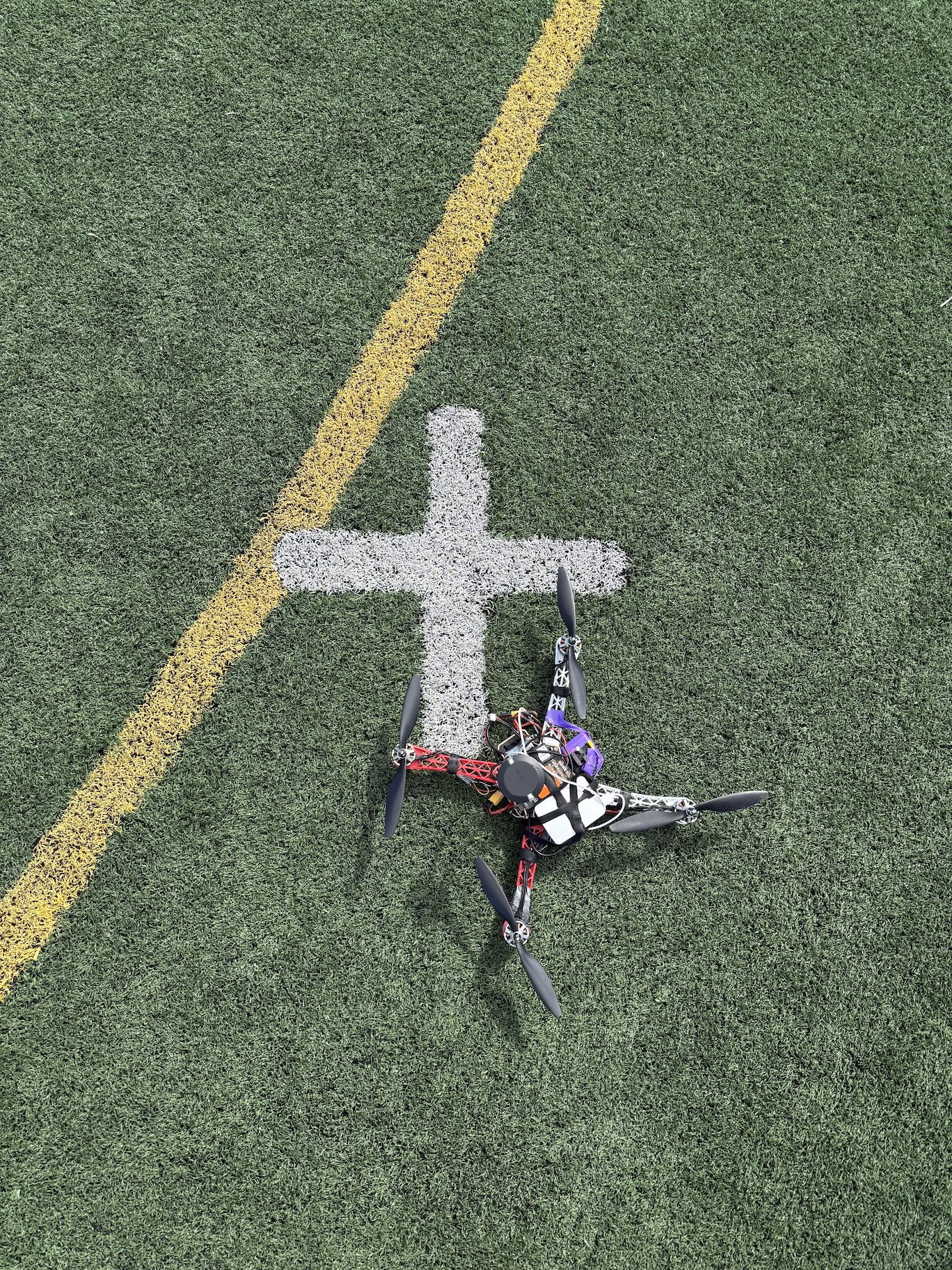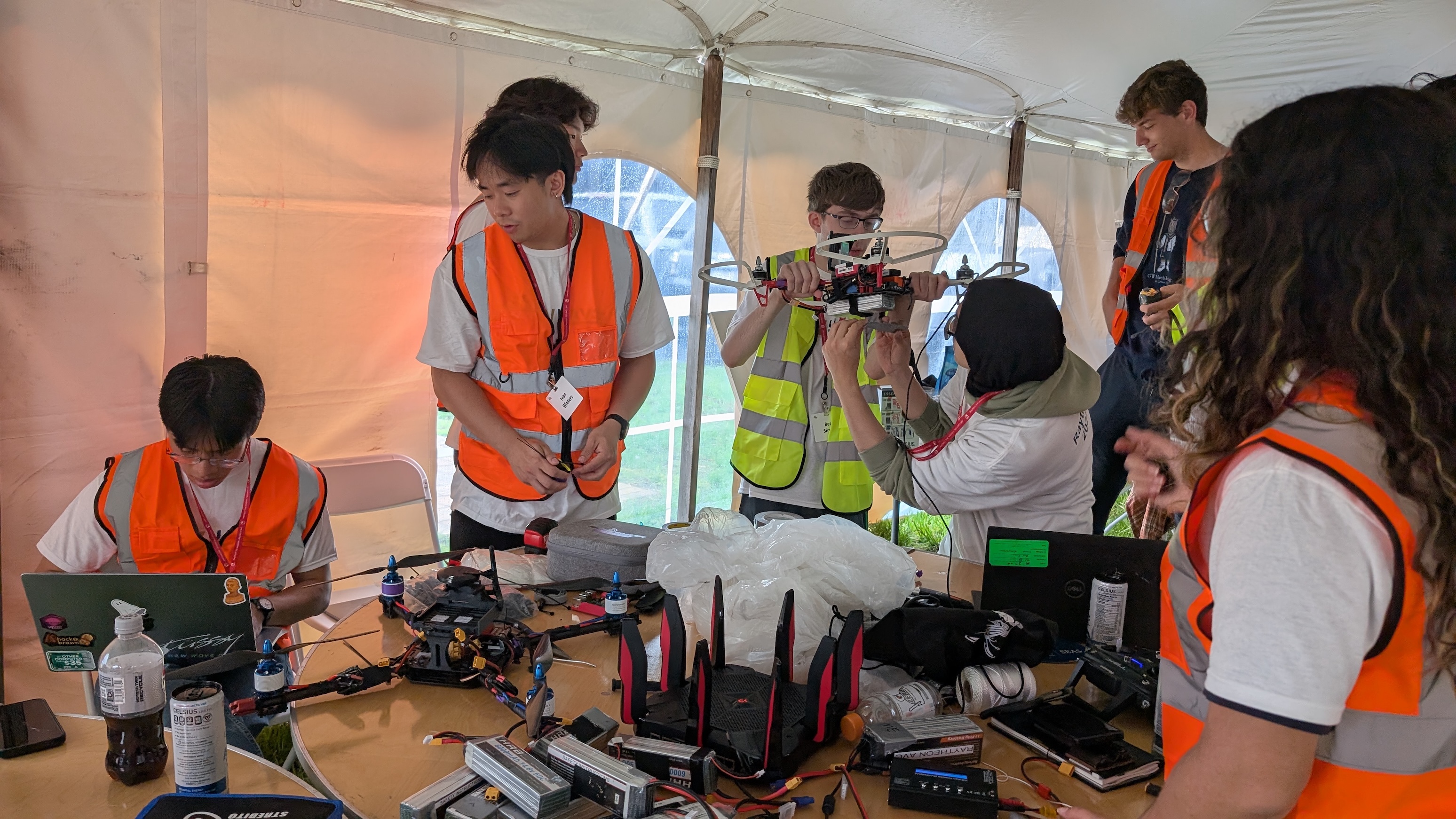The anticipation and excitement at the 2025 East Region Autonomous Vehicle Competition were palpable as student teams from the George Washington University (GW), Virginia Tech, George Mason University, Howard University, and the University of South Florida were asked to put their drones to one final test. After a year of hard work, adaptability, and creativity, the GW Engineering team was rewarded with the competition’s Most Innovative Design Award.
The interdisciplinary senior design capstone team, including students from the Computer Science (CS), Electrical and Computer Engineering (ECE), and Mechanical and Aerospace Engineering (MAE) Departments, spent the past year designing, building, and testing two autonomous aerial vehicles completely from scratch.
The competition, hosted by Raytheon, began in the early morning hours and lasted into the evening at the Xelevate drone ecosystem in Leesburg, Virginia.
The team’s goal was to create a dual drone system – one drone to scout QR code-like markers called ArUco markers in the airspace and send the marker’s coordinates to the delivery drone, and one to go to the specific coordinates and deliver a medkit package.

The team took an ambitious approach in designing their drone system. Using an aerial delivery drone was risky, given that the package they had to deliver weighed about 4 pounds, which is exceptionally heavy for a drone. The team carefully considered weight when developing the drone’s hardware and developed complex, unique algorithms to present an alternative to the parallel searching algorithms used by competitors.
The collaboration between students from different departments was the crux of the team’s success, says team member Ben Sirota.
“Being a multidisciplinary team was a huge advantage for us. Working with students from other disciplines isn’t something we get a lot of chances to do throughout our courses, so it was a very valuable experience for us to get opinions and insights from students with a different background,” Sirota said.
The multidisciplinary nature of the team allowed for successful task specialization and integration, Sirota explained. “For example, as an ECE student, I was in charge of communications, networking, and Linux scripting. We had MAE students in charge of designing hardware components and assembly, and CS students in charge of creating our high-level operational scripts.” By the end of the year, though, each of the team members had developed and applied new skills, often from outside of their home discipline.

The team’s ultimate success was also due to its ability to overcome the numerous challenges it faced during the past year of development.
The team struggled with the DC flight-restricted area, which required them to travel to Northern Virginia to test their drones every weekend starting in February. “It was a major disadvantage that we had to account for, but it also helped us to plan our time wisely,” said team captain Aarifah Ullah. “When we were on campus, we prepared by lining up and documenting tests we wanted to do out in the field. So our time was used efficiently and the next week we iteratively improved.”
The team also struggled with inclement weather the evening before and the morning of the competition. They worked into the early morning hours to develop a backup plan to account for the rain.
“We persevered a lot and didn’t give up. The reason we overcame the challenges was our commitment to doing our best,” Ullah concluded.
The multidisciplinary nature of the team necessitated faculty advisors from across the engineering school. MAE Professor Steven Shooter, ECE Professor Amir Aslani, and CS Professor Tim Wood served as the team’s faculty advisors, and all shared how impressed they were with the team’s growth throughout the year.
Prof. Shooter noted that the team worked hard to make the most of their multidisciplinary backgrounds. “The team responded by exploring different organizational structures and establishing sub-teams to tackle different technical challenges. It was great to see them come together and work as a team,” he said.
To Prof. Aslani, the iterative process of learning how to work together was as important as the technical work. “This journey not only honed their engineering competencies but also fostered a strong foundation of perseverance and teamwork that will undoubtedly support their future endeavors,” he concluded.
"This was our second year participating in the competition, and it was great to see the students proposing new designs and algorithms that went beyond our approach from last year,” Prof. Wood said. The team’s innovation and success have prompted growing interest in the competition. “We already have students asking to be part of the team for next year's competition,” he shared.


